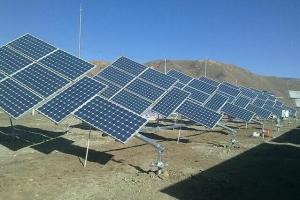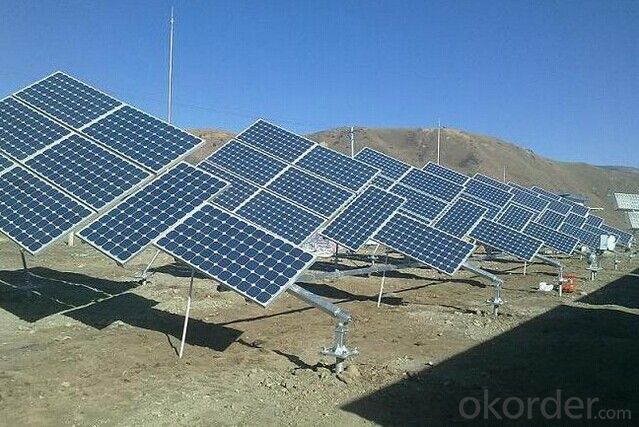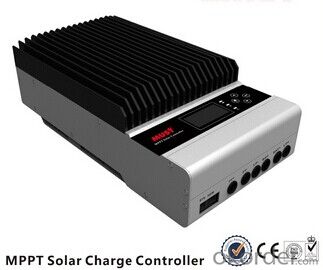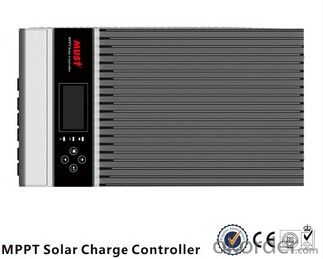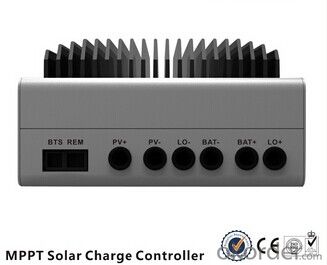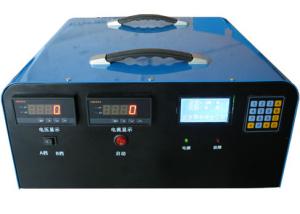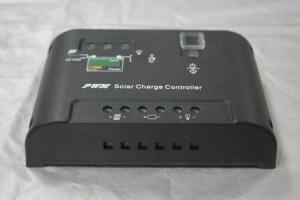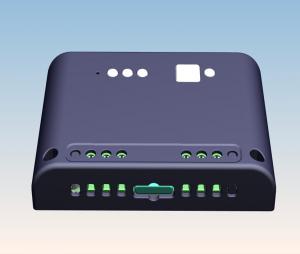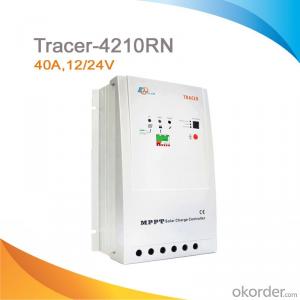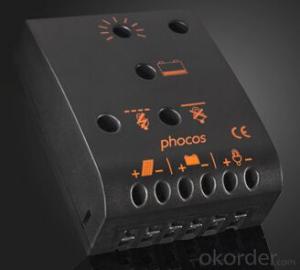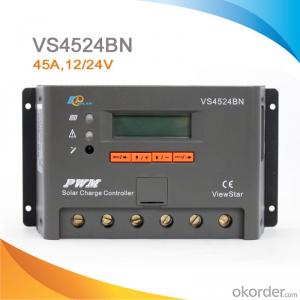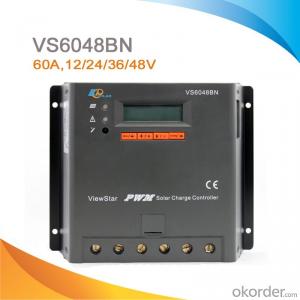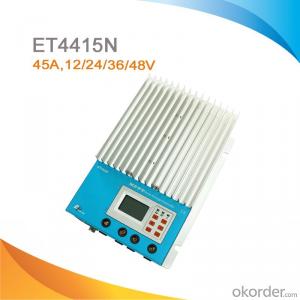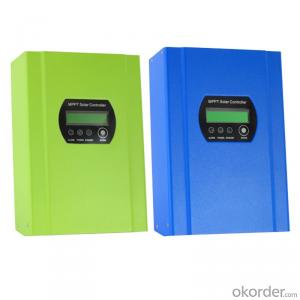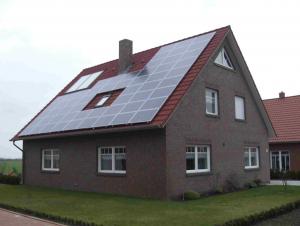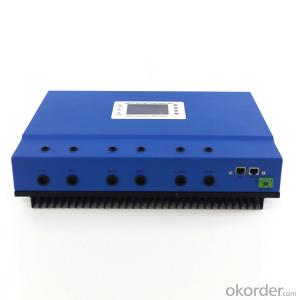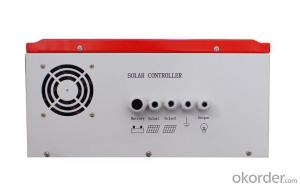Windy Nation MPPT Electronic Controller High Efficiency 45A Good Quality Solar Controllers
- Loading Port:
- Shekou
- Payment Terms:
- TT or LC
- Min Order Qty:
- 100 pc
- Supply Capability:
- 100000 pc/month
OKorder Service Pledge
OKorder Financial Service
You Might Also Like
MPPT Electronic Controller High Efficiency 45A
1. MPPT Solar Charger Controller Characteristics:
1. MPPT Solar charge controller 20A,30A,40A
2. MPPT efficiency max 99%,Peak conversion efficiency >98%
3.PV input :100V or 145V max
4.12v/24v auto work
5.DSP processors architecture ensures high speed and performance
6.Four stages charging method
7.Protection :PV arry short circuit ,PV reverse polarity ,battery reverse polarity,over charging ,output short circuit.
2. MPPT Electronic Controller specifications:
| Model | PC16-4515A | PC16-6015A | |
| Default Battery System Voltage | 12V/24V/36V/48VDC (adjustable) | ||
| CONTROLLER INPUT | PV Open Circuit Voltage Range | 16V~100V for 12V battery system/32V~145V for 24V battery system/ 48V~145V for 36V battery system/64V~145V for 48V battery system | |
| Max PV Input Power(12V) | 600W | 800W | |
| Max PV Input Power(24V) | 1200W | 1600W | |
| Max PV Input Power(36V) | 1800W | 2400W | |
| Max PV Input Power(48V) | 2400W | 3200W | |
| BATTERY | Limited charge voltage | 15.5~16.0VDC/31.0~32.0VDC/46.5~48.0VDC/62.0~64.0VDC | |
| Equalizing charge voltage | 15.0~15.5VDC/30.0~31.0VDC/45.0~46.5VDC/60.0~62.0VDC | ||
| Boost charge voltage | 14.0~15.0VDC/28.0~30.0VDC/42.0~45.0VDC/56.0~60.0VDC | ||
| Float charge voltage | 13.2~14.0VDC/26.4~28.0VDC/39.6~42.0VDC/52.8~56.0VDC | ||
| Equalizing charge interval | 3~30day | ||
| Equalizing charge time | 1H~3H | ||
| Boost charge time | 1H~3H | ||
| DC OUTPUT | Output Voltage | 9.8~16.0VDC/19.6~32.0VDC/29.4~48.0VDC/ 39.2~64.0VDC | |
| Peak Conversion Efficiency | 98% (MPPT Efficiency 99%) | ||
| Max Charging Current | 45A | 60A | |
| Warning for low voltage | 11.8VDC/23.6VDC/35.4VDC/47.2VDC(Adjustable) | ||
| Cutoff for low voltage | 9.8VDC/19.6 VDC/29.4VDC/39.2VDC(Adjustable) | ||
| Low voltage recovery | 12.0~13.0VDC/24.0~26.0 VDC/36.0~39.0VDC/48.0~52.0VDC(Adjustable) | ||
| GENERAL SPECIFICATION | Charge mode | MPPT, PWM, constant current-constant voltage, function of automatic protection for storage battery | |
| Radiating mode | Air cooling | ||
| Working mode | Four stage: Absorption CC, Absorption CV, Float CC, Float CV | ||
| Light controlled open voltage | 5V | ||
| Light controlled delay time | 5min | ||
| DISPLAY & PROTECTION | LED indication | Systematic operation, LV indication, LV protection, over charge protection, loads protection, short circuit protection | |
| LCD display | Charge voltage, charge current, voltage of storage battery, capacity of storage battery, output current | ||
| Alarm Protections | PV array short circuit, PV reverser polarity | ||
| Battery reverse polarity, Over charging protection | |||
| Output short circuit protection | |||
| Low voltage protection for storage battery | |||
| MECHANICAL SPECIFICATIONS | Mounting | Wall mount | |
| W*H* D(mm)/G.W(kg) | 170*259*128mm/4.2kg | 170*289*128mm/4.8kg | |
| OTHER | Environmental Rating | Indoor | |
| Operation Temperature Range | -35~45°C | ||
| Ambient humidity | 0~90% relative humidity(non-condensing) | ||
| Altitude | ≤3000m | ||
3. MPPT Solar Charger Controller Production Line:
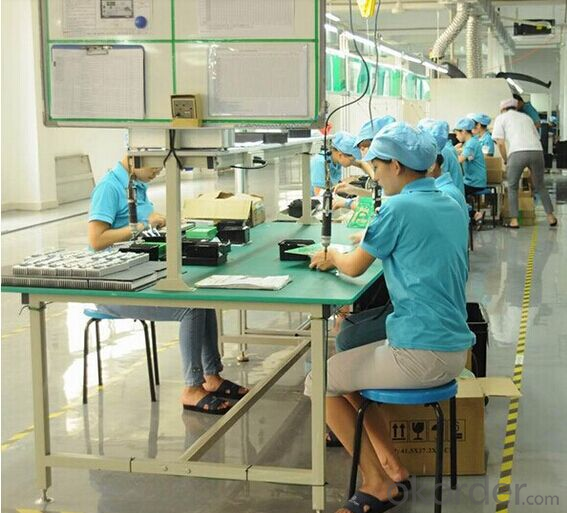
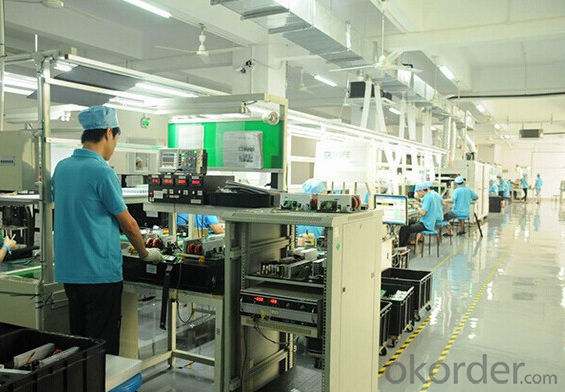
4. MPPT Solar Charger Controller FAQ:
We have organized several common questions for our clients, may help you sincerely:
1. How to choose a right solar controller?
Tell us your demand, then our sales will recommend a suitable one to you.
2. What is the solar inverter warranty?
Our product warranty is valid for 12 months after delivery. We undertake to repair any malfunctioned units due to defective components of inadequate workmanship ,but specially expecting any defects resulting from normal wear and tear of improper use of the products.
3. How long can we receive the product after purchase?
a.sample orders will be delivered from our factory within 7working days .
b.General orders(under 2000pcs) will be delivered from our factory within 25 working days.
c. Bulk orders (over 2000pcs )will be delivered from our factory within 35 working days at most
4. What is the payment term?
T/T (Telegraphic transfer) / Letter of credit
- Q: What are the main components of a solar controller?
- Solar controllers consist of a charge controller, a battery monitor, and a temperature sensor as their primary components. The charge controller's role is to regulate the voltage and current from the solar panels, ensuring the batteries are charged efficiently and safely. It prevents the batteries from overcharging or over-discharging, which can cause damage and reduce their lifespan. Modern charge controllers often incorporate maximum power point tracking (MPPT) technology, which continuously adjusts the voltage and current to match the batteries' requirements, optimizing the power output from the solar panels. The battery monitor is used to measure and display the state of charge (SOC) and voltage of the batteries. This information is vital for users to determine the remaining capacity of their batteries and estimate how long they can power their devices or systems. Advanced battery monitors may also provide additional data such as battery temperature, aiding in the effective management of the charging process. The temperature sensor is employed to monitor the temperature of the batteries. Elevated temperatures can adversely affect battery performance and lifespan. By using the temperature sensor, the solar controller can adjust the charging parameters based on the battery temperature, ensuring optimal charging and protection from excessive heat. In addition to these primary components, some solar controllers may offer features like LCD displays for convenient monitoring, USB ports for charging small electronic devices, and communication ports for data logging or remote monitoring. The specific components and features of a solar controller can vary depending on the model and manufacturer, but the charge controller, battery monitor, and temperature sensor are essential components that guarantee the efficient and safe operation of solar systems.
- Q: Do solar controllers require regular maintenance?
- Yes, solar controllers do require regular maintenance. While they are designed to be durable and reliable, regular maintenance is necessary to ensure their optimal performance and longevity. Some common maintenance tasks include cleaning the solar panels to remove any dirt or debris that could reduce their efficiency, inspecting the wiring and connections for any signs of damage or corrosion, and checking the controller's display and settings to ensure they are functioning properly. Additionally, it is recommended to periodically test the system's battery voltage and charge controller settings to ensure they are operating within the desired parameters. Regular maintenance not only helps to identify any potential issues early on but also helps to maximize the efficiency and lifespan of the solar controller.
- Q: How does a solar controller handle temperature compensation for the battery?
- A solar controller handles temperature compensation for the battery by monitoring the temperature of the battery and adjusting the charging voltage accordingly. As temperature affects the performance and lifespan of the battery, the controller ensures that the charging voltage is optimized based on the battery's temperature. This helps to prevent overcharging in high temperatures and undercharging in low temperatures, ensuring the battery remains in the optimal charging state for efficient and safe operation.
- Q: How does a solar controller handle temperature fluctuations?
- A solar controller handles temperature fluctuations by continuously monitoring the temperature of the solar panels. It adjusts the charging voltage and current to optimize the efficiency and performance of the solar panels according to the temperature. This helps to protect the panels from overheating in hot conditions and ensures maximum power output in colder temperatures.
- Q: Can a solar controller be used with a solar-powered waste management system?
- Yes, a solar controller can be used with a solar-powered waste management system. A solar controller is responsible for regulating the charge and discharge of batteries connected to the solar panel. In a solar-powered waste management system, the solar controller helps to efficiently charge and manage the batteries that power the system, ensuring optimal performance and longevity.
- Q: Can a solar controller be used with solar panels of different sizes?
- Yes, a solar controller can be used with solar panels of different sizes. A solar controller is responsible for regulating the charge from the solar panels to the battery bank or load, and it does not depend on the size of the solar panels. However, it is important to ensure that the solar controller is compatible with the voltage and current produced by the solar panels. The solar controller should have the appropriate specifications to handle the maximum voltage and current generated by the solar panels, regardless of their size.
- Q: How do I choose the right solar controller for my solar panel system?
- Choosing the right solar controller for your solar panel system is essential to ensure optimal performance and longevity of your system. Here are some key factors to consider when making your selection: 1. System Voltage: Determine the voltage of your solar panels and batteries. The solar controller should be compatible with the voltage of your system. Common voltages include 12V, 24V, and 48V. 2. Maximum Current: Consider the maximum current your solar panels can produce and choose a controller that can handle that current. It is important not to exceed the controller's maximum current rating to prevent damage. 3. Type of Controller: There are three main types of solar controllers: PWM (Pulse Width Modulation), MPPT (Maximum Power Point Tracking), and basic on/off controllers. PWM controllers are suitable for smaller systems, while MPPT controllers are more efficient and recommended for larger systems. 4. Efficiency: Look for a controller with high efficiency ratings, as this will help maximize the energy harvested from your solar panels, especially in low light conditions. 5. Load Control: Determine if you need a solar controller that can handle loads directly or if you will be using a separate load controller. Some controllers have built-in load control capabilities, allowing you to power low voltage appliances directly. 6. Temperature Compensation: If your solar panels will be exposed to varying temperatures, consider a controller with temperature compensation. This feature adjusts the charging parameters based on temperature, ensuring optimal charging and battery performance. 7. Protection Features: Ensure that the solar controller has protection features such as overcharge, over-discharge, short circuit, and reverse polarity protection. These features safeguard your batteries and equipment from damage. 8. Display and Monitoring: Consider controllers with built-in displays, as they provide valuable information about the system's performance and battery status. Some controllers also offer remote monitoring capabilities, allowing you to monitor your system from a distance. 9. Brand Reputation and Warranty: Research reputable brands known for producing reliable and durable solar controllers. Check for warranty information to ensure you are protected in case of any defects or malfunctions. Remember to consult with a professional or do thorough research before making your final decision. They can provide valuable insights and help you choose the solar controller that best fits your specific solar panel system requirements.
- Q: What is the maximum charging current that a solar controller can provide?
- The maximum charging current that a solar controller can provide depends on several factors including the specifications of the solar controller itself and the capacity of the battery being charged. Solar controllers typically have a maximum charging current rating, which is the maximum amount of current that it can safely provide to the battery. This rating can vary widely depending on the model and brand of the solar controller. Additionally, the maximum charging current that a solar controller can provide might also be limited by the capacity of the battery being charged. Some batteries have specific charging requirements and limitations, and exceeding these limitations can lead to damage or reduced battery lifespan. It is important to consult the specifications and guidelines of both the solar controller and the battery to determine the maximum charging current that can be safely utilized.
- Q: What are the different types of solar controllers?
- There are three main types of solar controllers: PWM (Pulse Width Modulation), MPPT (Maximum Power Point Tracking), and basic on/off controllers.
- Q: How do I determine the correct wire size for a solar controller?
- To determine the correct wire size for a solar controller, you need to consider a few factors. Firstly, you need to determine the maximum current that will be passing through the wire. This can be calculated by multiplying the maximum voltage of the solar controller by the maximum current output. Once you have the maximum current, you can refer to a wire size chart, which provides the recommended wire gauge based on the current rating. These charts are readily available online or at most electrical supply stores. It's important to note that wire size is typically measured in American Wire Gauge (AWG), where a smaller number represents a larger wire size. For example, a wire size of 2 AWG is larger than a wire size of 10 AWG. In addition to the current rating, you should also consider the length of the wire run. Longer wire runs result in higher resistance, leading to voltage drop. To mitigate this, you may need to choose a larger wire size to compensate for the distance. It's always recommended to err on the side of caution and choose a wire size that can handle slightly more current than what is expected. This ensures that the wire is not overloaded and minimizes the risk of overheating or damage. Lastly, it's crucial to follow any local electrical codes or regulations that may dictate the minimum wire size required for solar installations. These codes are in place to ensure safety and prevent any potential hazards. Overall, determining the correct wire size for a solar controller involves calculating the maximum current, referring to a wire size chart, considering the wire run length, and following any applicable electrical codes.
Send your message to us
Windy Nation MPPT Electronic Controller High Efficiency 45A Good Quality Solar Controllers
- Loading Port:
- Shekou
- Payment Terms:
- TT or LC
- Min Order Qty:
- 100 pc
- Supply Capability:
- 100000 pc/month
OKorder Service Pledge
OKorder Financial Service
Similar products
Hot products
Hot Searches
Related keywords
